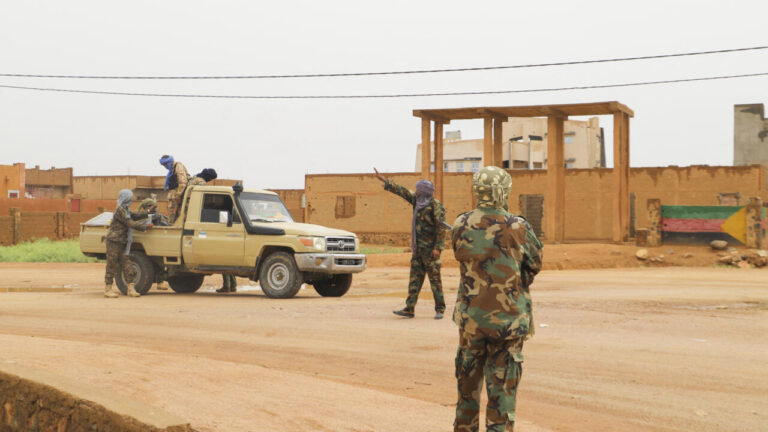Mali’s army is deploying towards a northern separatist rebel stronghold in a high-risk operation which could foreshadow a widescale confrontation and prove a turning point after a decade of conflict.
What’s happening on the ground?
A large Malian army convoy left the city of Gao on Monday headed towards the northern Kidal region.
It is reportedly to go first to the localities of Tessalit and Aguelhok north of the town of Kidal to take over camps being vacated by departing troops of the UN stabilisation force, MINUSMA.
The UN mission has been pushed out by the ruling junta and has been handing over its camps to Malian authorities.
The handover – which began with the camp at Ber in mid-August – is a prime factor in a recent resumption of hostilities by the separatists.
Against the backdrop of numerous armed groups vying for control, the separatists claim the UN sites should be returned to them.
The Coordination of Azawad Movements (CMA) – an alliance of predominantly Tuareg groups seeking autonomy or independence from the Malian state – has carried out a series of attacks on army positions since the Ber operation.
Its fighters are now regrouping in the Kidal region.
What’s at stake?
The desert region of Kidal is the historic centre of rebellions by the predominantly Tuareg separatists.
Uprisings by the nomadic, marginalised group have rocked Mali since independence from France in 1960.
Kidal lies more than 1,500 kilometres (more than 930 miles) from the capital Bamako and the northern camps are a crucial stopover between Mali and Algeria.
The whole region is strategic but the town of Kidal is the crown jewel.
The army suffered several humiliating defeats by the separatists between 2012 and 2014.
The fact that Kidal is still controlled by the rebels remains a source of irritation for the junta, who seized power in 2020.
Re-establishing state control across the whole country is one of its main messages.
What’s the army’s capacity?
When the rebels, both separatists and Salafists, rose up in northern Mali in 2012, quickly followed by jihadists, the army had around 12,000 men, according to a 2013 French parliamentary report.
After 10 years of French and European followed by Russian military assistance, its numbers grew to around 40,000.
Several hundred members of Russia’s private paramilitary Wagner group are believed to be in Mali – enough to convince the junta to again take on the rebels, according to a Western diplomat.
But the contingent is not enough to take back control of a country already under pressure from a jihadist insurgency.
“The Malian forces’ strategic problem is their lack of resources,” Jonathan Guiffard, an expert associated with the independent Institute Montaigne think tank in Paris, said.
“Either they endure, or they carry out dynamic operations which result in raids here and there. It’s the most they can do,” he said.
The army has air power acquired in 2022 which includes three Turkish-made Bayraktar drones as well as L39 Albatros aircraft provided by Russia, although their availability and efficiency in combat remains uncertain.
And the separatists?
No credible data is available on the CMA’s ranks.
“They have often lied to boost their numbers (as part of a disarmament programme) and have hidden their stocks of weapons,” Marc-Andre Boisvert, a researcher at the Centre FrancoPaix based in Canada said.
Before the renewed hostilities, a realistic figure for the rebels would have been 3,000 to 4,000, he said.
As well as their permanent forces, their organisation allows them to mobilise more troops for limited periods of time – a call to mobilise went out on Tuesday.
According to Guiffard, the CMA is battling a certain “inertia” from a decade of no fighting.
“The CMA is less prepared than in 2012 but has the land to itself and is accustomed to an asymmetrical war strategy,” he said.
As for its weaponry, little is known. The Kidal region is reputed to be a corridor for the trafficking of arms from Libya.
The CMA claims to have shot down several Malian aircraft in recent weeks but while the loss of some has been verified, the circumstances have not.
Relationship between rebels and jihadists
The separatists’ attacks coincide with a resurgence in activity claimed by the Al-Qaeda-affiliated jihadist alliance Support Group for Islam and Muslims (GSIM).
Observers see some informal ties between the separatists and jihadists despite clear distinctions too.
The GSIM and related groups have always had their own agenda and command chains “with objectives which have nothing to do with those of the components of the CMA”, Guiffard said.
However, there is a “fluidity between the families, the tribes”, he added.
“It’s logical for social survival.”
(AFP)



